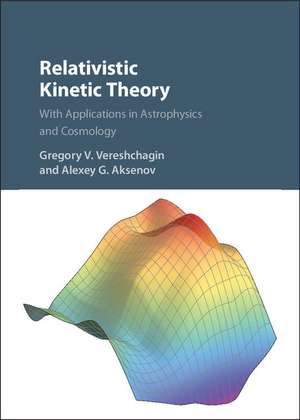Relativistic Kinetic Theory: With Applications in Astrophysics and Cosmology
Autor Gregory V. Vereshchagin, Alexey G. Aksenoven Limba Engleză Hardback – 15 feb 2017
Preț: 972.63 lei
Preț vechi: 1130.97 lei
-14% Nou
186.14€ • 192.29$ • 154.91£
Carte tipărită la comandă
Livrare economică 26 martie-09 aprilie
Specificații
ISBN-10: 1107048222
Pagini: 334
Ilustrații: 54 b/w illus.
Dimensiuni: 184 x 262 x 24 mm
Greutate: 0.81 kg
Editura: Cambridge University Press
Colecția Cambridge University Press
Locul publicării:New York, United States
Cuprins
Preface; Acknowledgements; Acronyms and definitions; Introduction; Part I. Theoretical Foundations: 1. Basic concepts; 2. Kinetic equation; 3. Averaging; 4. Conservation laws and equilibrium; 5. Relativistic BBGKY hierarchy; 6. Basic parameters in gases and plasmas; Part II. Numerical Methods: 7. The basics of computational physics; 8. Direct integration of Boltzmann equations; 9. Multidimensional hydrodynamics; Part III. Applications: 10. Wave dispersion in relativistic plasma; 11. Thermalization in relativistic plasma; 12. Kinetics of particles in strong fields; 13. Compton scattering in astrophysics and cosmology; 14. Self-gravitating systems; 15. Neutrinos, gravitational collapse and supernovae; Appendices; Bibliography; Index.
Descriere
Relativistic kinetic theory has widespread application in astrophysics and cosmology. The interest has grown in recent years as experimentalists are now able to make reliable measurements on physical systems where relativistic effects are no longer negligible. This ambitious monograph is divided into three parts. It presents the basic ideas and concepts of this theory, equations and methods, including derivation of kinetic equations from the relativistic BBGKY hierarchy and discussion of the relation between kinetic and hydrodynamic levels of description. The second part introduces elements of computational physics with special emphasis on numerical integration of Boltzmann equations and related approaches, as well as multi-component hydrodynamics. The third part presents an overview of applications ranging from covariant theory of plasma response, thermalization of relativistic plasma, comptonization in static and moving media to kinetics of self-gravitating systems, cosmological structure formation and neutrino emission during the gravitational collapse.






